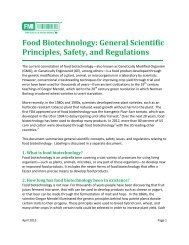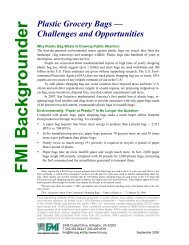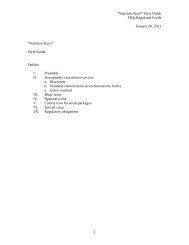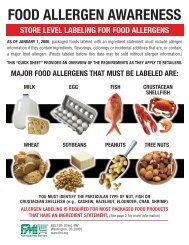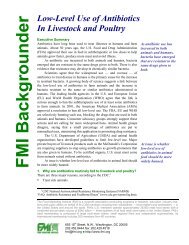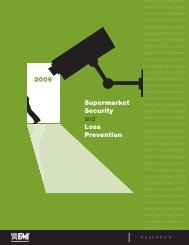Consumer Shopping Habits for Wellness and Environmentally ...
Consumer Shopping Habits for Wellness and Environmentally ...
Consumer Shopping Habits for Wellness and Environmentally ...
You also want an ePaper? Increase the reach of your titles
YUMPU automatically turns print PDFs into web optimized ePapers that Google loves.
fact, probing conversations with consumers often result in nominal guesses such as ―Well, I suppose<br />
they could recycle paper in their home office, wherever that is.‖<br />
That being said, much of the impression that consumers gather about a store relative to issues of<br />
sustainability issues relates directly to items on the shelf – if a store carries products that appear<br />
better <strong>for</strong> the environment (or, less-directly, simply ―healthier‖), then, at least in a vague sense, then<br />
the store seems like it is being ―responsible.‖ For instance, stores that carry a full (<strong>and</strong> visible)<br />
selection of natural home cleaners will be thought of as ―better‖ in an environmental sense by<br />
consumers than stores that carry only conventional br<strong>and</strong>s. Product selection is one reason why<br />
specialty retailers consistently deliver superior sustainability or responsibility impressions to<br />
consumers. Rolling out more natural products in the key categories we outline <strong>for</strong> each retail channel<br />
is perhaps the most immediately effective, sustainability-related step retailers could take. In addition,<br />
playing up specific category decision criteria that relate to sustainability or responsibility in displays<br />
<strong>and</strong>/or promotions may be quite helpful, e.g. ―not animal tested‖ <strong>for</strong> certain personal care products.<br />
Labor issues also arise frequently. Many consumers move discussion toward ―happy employees‖<br />
when sustainability issues are brought into a conversation (usually by researchers, not consumers) –<br />
in some sense, consumers assume that if store employees seem pleasant, that they are being<br />
treated well, <strong>and</strong> that the store is ―nice‖ in other respects as well, e.g. is ―nice,‖ or, rather,<br />
responsible, when it comes to caring about the environment.<br />
Store environment also impacts how consumers perceive sustainability. In many ways, the less<br />
―traditional‖ a store appears, <strong>and</strong> the more contemporary <strong>and</strong> ―high quality‖ a store looks, the more<br />
sustainable it seems. For instance, consumers are generally unlikely to rate a conventional mass<br />
retailer with bright lighting <strong>and</strong> high, utilitarian metal shelving as particularly sustainable or<br />
responsible; such a setting seems like ―retail‘s past,‖ recalling an era that came be<strong>for</strong>e the current<br />
one <strong>and</strong> its ―green‖ emphasis. Conversely, stores with contemporary lighting, flooring, shelving, et<br />
cetera appear ―with it‖ <strong>and</strong> up-to-date, <strong>and</strong> presumably participating in this new era of<br />
sustainability/responsibility. While this sounds terribly superficial, we find that such appearances<br />
consistently produce better sustainability impressions (in addition to better H+W <strong>and</strong> overall quality<br />
impressions).<br />
Health Services or Learning Features?<br />
In-store health services <strong>and</strong> learning features st<strong>and</strong> apart from one another to some degree.<br />
Where there is a strong presence of one, typically the other has a weak presence. To be certain, it<br />
would seem odd to find a flu shot booth in proximity to specialist store employees explaining the<br />
virtues of all-natural skincare regimes. Unsurprisingly, consumer opinions of the appropriateness<br />
<strong>and</strong> desirability of health services <strong>and</strong> learning features are highly dependent on the type of retailer.<br />
For the most part, there is a continuum between the two, summarized in the diagram below. At the<br />
left of the diagram, we see the channels where services are most desirable, <strong>and</strong> at the right, where<br />
learning is most desirable. Mainstream grocery stores, appearing in the middle of the chart, are<br />
faced with a balancing act.<br />
150




